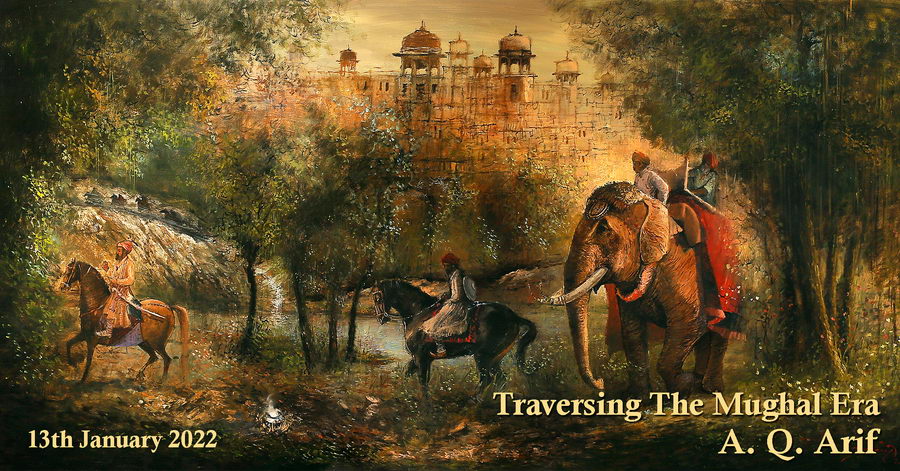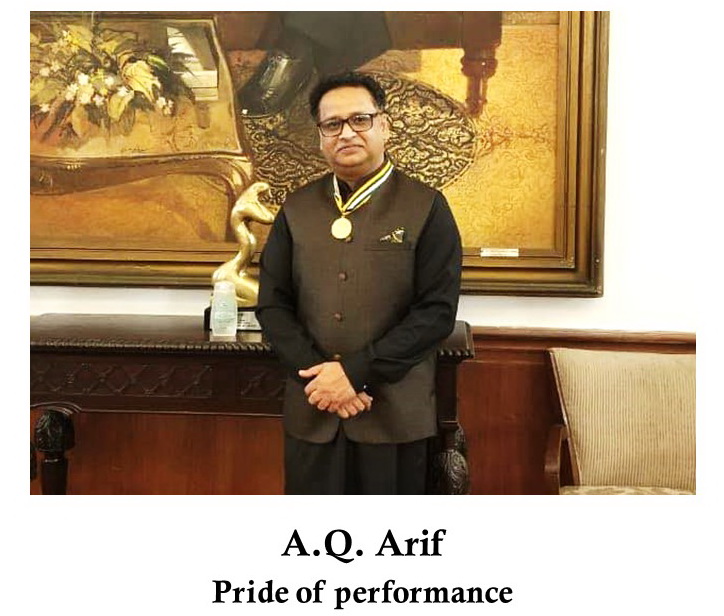Traversing The Mughal Era by A.Q. Arif (13th –20th January 2022)

Invites you to
An exclusive exhibition of paintings
Traversing The Mughal Era
by
AQ Arif
13th – 20th Janurary 2021
Exhibition Opening
13th Janurary 2021
6pm - 8pm
Visit our gallery or view the virtual exhibition
on www.artciti.com
All SOPs must be strictly followed.

A.Q. Arif was born in 1975 in a family that had no connection to the art world. Only his mother was a writer who first noticed him spending countless hours drawing and painting on papers and rags he would find around the house. His mother then cultivated this interest and supported his decision to study fine arts.
Arif started his academic study of fine arts at the Karachi School of Arts in 1992 and finished his final year with a 2nd position in the province of Sindh. He finished his degree in 1996 and started participating in group exhibitions all over the city of Karachi.
His first big break was in 2003 at Chawkandi Gallery where his first solo exhibition was completely sold out. Since then, he has had 23 solo exhibitions around the world with countless group exhibitions. Meanwhile, he has also concentrated on teaching the students of Pakistan and has taught at Indus Valley School of Arts, Karachi School of Arts, Mashkoor School of Arts, Textile Institute of Pakistan, Iqra University, and North City School of Arts.
He has supported students to break into the art world and to begin a dialogue into bringing South-Asian art infront of eyes of the mainstream. In 2014, he was awarded the International Best Artist award by Trevisan Art Gallery in Italy. His work was also a part of an auction of south-Asian contemporary artists at BONHAMs auction house in 2017 where it set a new record for his work.
Arif’s work is a part of many public and private collections around the world. He is currently a member of the American Impressionist Society and the Watercolor Art Society of Houston where he currently resides. In 2020 he was also awarded the Presidential Award for Pride of Performance by the Government of Pakistan.
The genesis of war is as old as history. Human beings have been fighting for power and supremacy from the moment they began to run out of resources and starve leading to ruthless greed. Today, history is replete with conflicts, battles and wars that were fought for a variety of reasons such as forcing ideological change, settling border disputes, capturing mineral resources among others.
Accentuating the brave nature of defending warriors, A Q Arif has put together a unique set of aesthetically modelled artworks. Additionally, being a highly acknowledged painter of cityscapes and Islamic buildings, the artist in the current exhibits, introduces a new wave of captivating structures draped in Muslim architecture. The segment of paintings depicting the grand era of the Mughals, reflect the artist's vivid vision, eye for detail and a keen urge to define the atmosphere of combat. The visually complex subject of armed conflicts comprising armor, weapons and dynamic articulation, is a daunting theme that Arif confronts head-on. The historical nature of painted episodes is crucial to the preservation of past history of the subcontinent some grand and some humiliating! The artist indeed has manifested his command over this exclusive subject narrating some of the significant junctures of battle, which now stand preserved. The remarkable demeanor of courage, gracefully composed for movement and posture, these paintings exude inspiration and induce a winning spirit to struggle. The artist, through his extraordinary arrangements on the canvas, has revived the powerful imagery of the region's ancestors, which oozes with inspiration to fortify defenses of the motherland.
Retrospectively, ever since the Indus Valley Civilization (3300-1300 BC), successive kingdoms and empires invaded and ruled the region and enriched its culture - from the Achaemenid Persian empire, to Alexander the Great. Muslim rule in the subcontinent began in 712 AD when Muhammad bin Qasim conquered Sindh and Multan, setting off several successive invasions leading to the formation of Muslim empires of Delhi Sultanate and the Mughal Empire. It was the Mughal rulers who introduced middle-eastern art and architecture to India. The emerging Mughal army developed a superior cavalry branch. The cavalry's horsemen possessed horses and used a wide variety of weapons like swords, shields, lances, more rarely guns. Their armor was made up of steel or leather, and they wore the traditional dress of their tribes. Arif portrays the aforesaid with masterful imagination deploying painterly realism, especially, the Mughal cavalry with elephants bearing richly ornamented sturdy armor.
Among the Mughal military, the artist portrays warships and boats which were used for defending coastlines, controlling piracy and for transportation of men and goods. The inclusion of maritime activity, amidst the subject of warriors, strengthens the artist's archival aspiration, capturing the essence of sixteenth century Akbarnama paintings of Mughal court painters that depict battles on the Ganges river.
Arif underpins the soft aspect of Mughal lifestyle through artistic representation of royal attire of men and women. Portraits of graceful women dressed in glorious apparel of that era, convey an insight on the feminine grandeur and beauty. Imparting a majestic textural persona to the paintings, the artist handles paints in a variety of application techniques, ranging from scumbling and stippling to bold impasto strokes. Culminating into an enhanced and a more gratifying style, Arif has achieved a distinguished disposition amongst leading painters. The singularity of the artist's concepts and perception emerging from history, emphasizes the significance of learning from the past; specifically, when the homeland is threatened by conniving adversaries.
M Saeed Kureshi
Sitar-e-Imtiaz
Art Critic
A. Q. Arif, 18 x 24 Inch, Oil On Canvas, Figurative Painting, AC-AQ-396
A. Q. ARIF I paint the glories of nature and magnificence of God. I believe that there is nothing..
$110,000.00 Ex Tax: $110,000.00
A. Q. Arif, Ethereal, 52 x 96 Inch, Oil On Canvas, Citiscape Painting, AC-AQ-395
A. Q. ARIF I paint the glories of nature and magnificence of God. I believe that there is nothing..
$1,000,000.00 Ex Tax: $1,000,000.00
A. Q. Arif, Keepers at the River Side, 48 x 60 Inch, Oil On Canvas, Citiscape Painting, AC-AQ-387
A. Q. ARIF I paint the glories of nature and magnificence of God. I believe that there is nothing..
$650,000.00 Ex Tax: $650,000.00
A. Q. Arif, Preparing to make their mark at the hunt, 36 x 72 Inch, Oil On Canvas, Citiscape Painting, AC-AQ-388
A. Q. ARIF I paint the glories of nature and magnificence of God. I believe that there is nothing..
$750,000.00 Ex Tax: $750,000.00
A. Q. Arif, Quick Strategic Stop, 48 x 72 Inch, Oil On Canvas, Citiscape Painting, AC-AQ-393
A. Q. ARIF I paint the glories of nature and magnificence of God. I believe that there is nothing..
$800,000.00 Ex Tax: $800,000.00
A. Q. Arif, Royal Escort, 36 x 72 Inch, Oil On Canvas, Citiscape Painting, AC-AQ-389
A. Q. ARIF I paint the glories of nature and magnificence of God. I believe that there is nothing..
$750,000.00 Ex Tax: $750,000.00
A. Q. Arif, Royal Fishing Harbour, 48 x 60 Inch, Oil On Canvas, Citiscape Painting, AC-AQ-386
A. Q. ARIF I paint the glories of nature and magnificence of God. I believe that there is nothing..
$650,000.00 Ex Tax: $650,000.00
A. Q. Arif, Serenading the Princesses, 48 x 72 Inch, Oil On Canvas, Citiscape Painting, AC-AQ-391
A. Q. ARIF I paint the glories of nature and magnificence of God. I believe that there is nothing..
$800,000.00 Ex Tax: $800,000.00
A. Q. Arif, The Conqueror Returns, 36 x 72 Inch, Oil On Canvas, Citiscape Painting, AC-AQ-390
A. Q. ARIF I paint the glories of nature and magnificence of God. I believe that there is nothing..
$750,000.00 Ex Tax: $750,000.00
A. Q. Arif, The Forgotten Princess, 22 x 28 Inch, Oil On Canvas, Figurative Painting, AC-AQ-381
A. Q. ARIF I paint the glories of nature and magnificence of God. I believe that there is nothing..
$150,000.00 Ex Tax: $150,000.00
A. Q. Arif, The Misty Banks of Ravi, 48 x 48 Inch, Oil On Canvas, Cityscape Painting, AC-AQ-382
A. Q. ARIF I paint the glories of nature and magnificence of God. I believe that there is nothing..
$550,000.00 Ex Tax: $550,000.00
A. Q. Arif, The Mughal Entourage, 48 x 72 Inch, Oil On Canvas, Citiscape Painting, AC-AQ-392
A. Q. ARIF I paint the glories of nature and magnificence of God. I believe that there is nothing..
$800,000.00 Ex Tax: $800,000.00
A. Q. Arif, The Royal Steed, 48 x 48 Inch, Oil On Canvas, Horse Painting, AC-AQ-384
A. Q. ARIF I paint the glories of nature and magnificence of God. I believe that there is nothing..
$550,000.00 Ex Tax: $550,000.00
A. Q. Arif, The Valiant Prince, 48 x 48 Inch, Oil On Canvas, Citiscape Painting, AC-AQ-383
A. Q. ARIF I paint the glories of nature and magnificence of God. I believe that there is nothing..
$550,000.00 Ex Tax: $550,000.00
A. Q. Arif, Tranquility, 48 x 60 Inch, Oil On Canvas, Citiscape Painting, AC-AQ-385
A. Q. ARIF I paint the glories of nature and magnificence of God. I believe that there is nothing..
$650,000.00 Ex Tax: $650,000.00
















